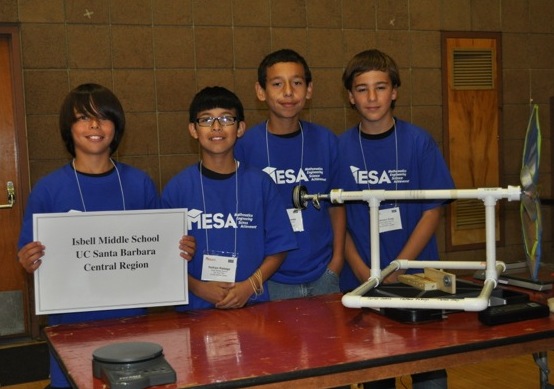
Middle School Students in MESA Program Will Represent California in National Engineering Competition
The Pop Flies, a team of four sixth-graders from UC Santa Barbara's Mathematics, Engineering and Science Achievement (MESA) program, will represent their home state in the National Engineering Design –– Wind Energy Challenge to be held June 22-24 at the Boeing Assembly Facility in Renton, Wash.
The students, all from Isbell Middle School in Santa Paula, earned the right to compete nationally by taking first place honors in the statewide finals of the MESA Wind Energy Challenge, which UCSB hosted in May. The youngest of all middle school competitors, the Pop Flies beat hundreds of other students from MESA programs across California.
The students –– Tobin Fincher, Carlos Gomez, Carson Gray, and Nathan Rabago –– will be accompanied to Washington by Mario Castellanos and Phyllis Brady, director and assistant director, respectively, of UCSB MESA; and by Cari Leidig and Diana Georghiou, Isbell Middle School teachers and the Pop Flies' MESA advisors.
At the competition, Fincher, Gomez, Gray, and Rabago will be judged on their device's mechanical power and wind-to-vehicle transfer power, as well as on their oral presentation, technical paper, and academic display. This marks the third year that Isbell Middle School teams have placed in the statewide Wind Energy Challenge, and the first time they advanced to national competition as California's team.
In addition to the Pop Flies' accomplishment, a team from Santa Paula High School placed third in the statewide Wind Energy Challenge at the high school level, an honor the school has held all three years of the Wind Energy Challenge event.
"What an impressive achievement for our MESA UCSB team," said Glen Beltz, associate dean of UCSB's College of Engineering, professor of mechanical engineering, and MESA's principal investigator. "These students spent countless hours working after school and on weekends perfecting their designs. Carlos, Tobin, Carson, and Nathan epitomize what it means to be state champions in MESA."
Focusing on wind energy reflects MESA's goal of staying current with trends in science, engineering, and technology. Wind energy projects teach students design principles while encouraging them to think like environmental scientists. Balancing the complexity of the assignments with social benefits, such as energy efficiency, brings these MESA lessons home.
Supported by the College of Engineering and the Office of Education Partnerships, MESA serves more than 20,000 K-12, community college, and four-year college students each year. The program prepares students academically so they graduate with baccalaureate degrees in math-related disciplines. A total of 70 percent of MESA high school graduates pursue college degrees. In comparison, 48 percent of all California high school graduates go to college. UCSB is among the top university destinations for MESA high school graduates.
The program serves educationally disadvantaged students and is open to all first-generation college-bound students. Many students are also from low-income backgrounds. The program includes academic counseling, classroom support, and hands-on projects. Industrial partners provide financial assistance for campus workshops and science and engineering competitions, scholarships, and internships.
MESA has been recognized as an outstanding public program by Innovations in American Government, a project of the Kennedy School of Government at Harvard University and the Ford Foundation. MESA has also received the Presidential Award for Excellence in Science, Mathematics, and Engineering Mentoring.
Related Links



